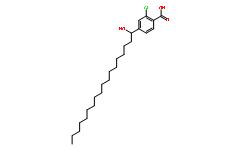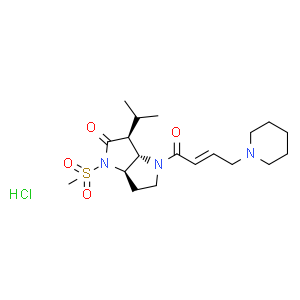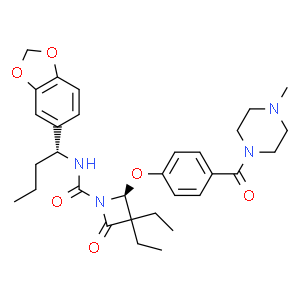| 中文名称: | ZD8321 | ||||
|---|---|---|---|---|---|
| 英文名称: | ZD8321 | ||||
| 别名: | ZD8321 N-(Methoxycarbonyl)-L-valyl-N-((1S)-3,3,3-trifluoro-1-(1-methylethyl)-2-oxopropyl)-L-prolinamide | ||||
| CAS No: | 182073-77-4 | 分子式: | C18H28F3N3O5 | 分子量: | 423.43 |
| CAS No: | 182073-77-4 | ||||
| 分子式: | C18H28F3N3O5 | ||||
| 分子量: | 423.43 | ||||
基本信息
|
产品编号: |
Z10090 |
||||
|
产品名称: |
ZD8321 |
||||
|
CAS: |
182073-77-4 |
储存条件 |
粉末 |
-20℃ |
四年 |
|
|
|
||||
|
分子式: |
溶于液体 |
-80℃ |
六个月 |
||
|
分子量 |
423.43 |
-20℃ |
一个月 |
||
|
化学名: |
N-(Methoxycarbonyl)-L-valyl-N-((1S)-3,3,3-trifluoro-1-(1-methylethyl)-2-oxopropyl)-L-prolinamide |
||||
生物活性
|
产品描述 |
一种人 Neutrophil elastase (NE) 的有效抑制剂。 |
|
靶点 |
Ki: 13±1.7nM (Neutrophil elastase) |
|
体外研究 |
TNFα-activated HUVEC is dose dependently inhibited by ZD8321.The adhesion between cancer cells with high elastase activity and TNFα-activated HUVEC is also inhibited by ZD8321. Expression of cell surface E-selectin by NE stimulation is suppressed in the presence of ZD8321. The concentration of soluble E-selectin in the medium increases after adhesive reaction between neutrophils and HUVEC. This increase is also dose dependently inhibited by ZD8321 |
推荐实验方法(仅供参考)
|
Cell Assay |
HUVECs are cultured in RPMI 1640 containing 5% FBS for 6h in collagen-coated, 24-well plates before the experiment. Some of the confluent HUVECs are further incubated with TNFα (1ng/mL) and ZD8321 (0-50mM), or with human NE (0-100ng/mL) for 4h at 37°C. For adhesion assays, cancer cells resuspended in RPMI 1640 containing 5% FBS are added to each HUVEClayered well. The plates are shaken at 700 rpm for 10 min at room temperature, washed twice with PBS, and examined by phase-contrast microscopy to determine the number of cells bound onto the HUVEC monolayer. The adhesive reactions of neutrophils to HUVEC are also analyzed in this manner |
本计算器可帮助您计算出特定溶液中溶质的质量、溶液浓度和体积之间的关系,公式为:
质量 (g) = 浓度 (mol/L) x 体积 (L) x 分子量 (g/mol)
摩尔浓度计算公式
用本工具协助配置特定浓度的溶液,使用的计算公式为:
开始浓度 x 开始体积 = 最终浓度 x 最终体积
稀释公式
稀释公式一般简略地表示为:C1V1 = C2V2 ( 输入 输出 )










